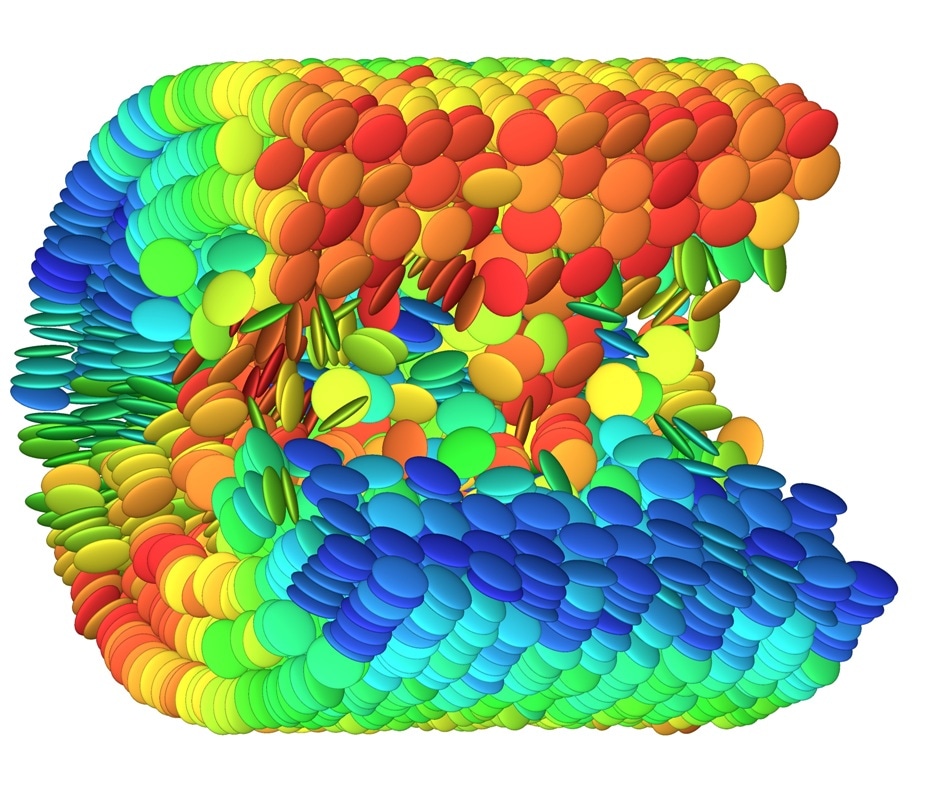Feb 8 2018
Researchers have analyzed an interesting form of self-assembly in liquid crystals, at PETRA III X-ray source at DESY — on filling the liquid crystals into cylindrical nanopores and heating them, ordered rings are formed by their molecules upon being cooled, a state that normally does not occur naturally in the material.
The team headed by Patrick Huber from Hamburg University of Technology (TUHH) has described in the Physical Review Letters journal that such a function enables developing nanomaterials with innovative electrical and optical characteristics.
 Cutaway-view into a largely self-organized liquid crystal in a nanopore. (Image credit: A. Zantop/M. Mazza/K. Sentker/P. Huber, Max-Planck Institut für Dynamik und Selbstorganisation/Technische Universität Hamburg (TUHH))
Cutaway-view into a largely self-organized liquid crystal in a nanopore. (Image credit: A. Zantop/M. Mazza/K. Sentker/P. Huber, Max-Planck Institut für Dynamik und Selbstorganisation/Technische Universität Hamburg (TUHH))
The researchers investigated a distinctive class of liquid crystals that included disk-shaped molecules known as discotic liquid crystals. In such materials, the disk molecules have the ability to create high, electrically conductive pillars on their own by getting stacked like coins. The team filled nanopores in a silicate glass with discotic liquid crystals. The diameter of the cylindrical pores was just 17 nm (or one-millionths of 1 mm) and a depth of 0.36 mm.
After being filled, the liquid crystals were heated to nearly 100 °C and cooled gradually. Concentric rings arrayed like round curved columns were formed by the initially disorganized disk molecules. Beginning at the edge of the pore, the rings were slowly formed one after the other with the decrease in temperature. When the temperature reached around 70 °C the complete cross-section of the pore was packed by concentric rings. When the crystals were reheated, the rings slowly started to disappear.
“This change of the molecular structure in confined liquid crystals can be monitored with X-ray diffraction methods as a function of temperature and with high accuracy,” stated Milena Lippmann, DESY scientist and co-author of the study who prepared and took part in the experiments at the High-Resolution Diffraction Beamline P08 at PETRA III. “The combination of symmetry and confinement gives rise to unexpected, new phase transitions,” stated Marco Mazza from the Max Planck Institute for Dynamics and Self-Organization in Göttingen, where the process was designed by means of computer simulations. For this reason, MPI researcher Arne Zantop formulated a numerical and theoretical model for the nano-confined liquid crystals that corroborated the experimental outcomes and assisted in interpreting them.
The individual rings were formed step by step at specific temperatures. “This makes it possible to turn individual nanorings on and off by small changes in temperature,” reiterated Kathrin Sentker (lead author of the study who is from TUHH). She had observed this phenomenon through strikingly stepwise signal changes in laser-optical experiments. Although such quantized changes normally occur only at lower temperatures, the liquid crystal system exhibits a quantum behavior already well above ambient temperature.
Due to the fact that the optoelectrical characteristics of discotic liquid crystals get modified when molecular columns are formed, the nanopore-confined alternative is a propitious material for developing innovative optical metamaterials with characteristics that can be regulated stepwise by changing the temperature. The analyzed nanostructures can also result in innovative applications in organic semiconductors, for example, temperature-switchable nanowires, described Andreas Schönhals, co-author of the study, from the Bundesanstalt für Materialforschung und -prüfung (BAM), the German Federal Institute for Materials Research and Testing, who has been intrigued by the electrical and thermal characteristics of such materials.
The phenomenon constitutes a fine example how versatile soft matter can adapt to extreme spatial constraints and how this can lead to new insights in physics as well as new design and control principles for the self-organization of functional nanomaterials.
Patrick Huber, Principal Investigator
Scientists from Helmholtz-Zentrum Berlin (HZB) and from Czestochowa University of Technology in Poland also participated in this research. Sentker and Huber are members of the Collaborative Research Initiative SFB 986 “Multi-Scale Materials Systems” committed to developing materials with customized electrical, mechanical, and photonic characteristics. The study, which draws together the materials research proficiencies in the Hamburg metropolitan area, is funded by Deutsche Forschungsgemeinschaft (DFG), the central self-governing research funding organization in Germany.